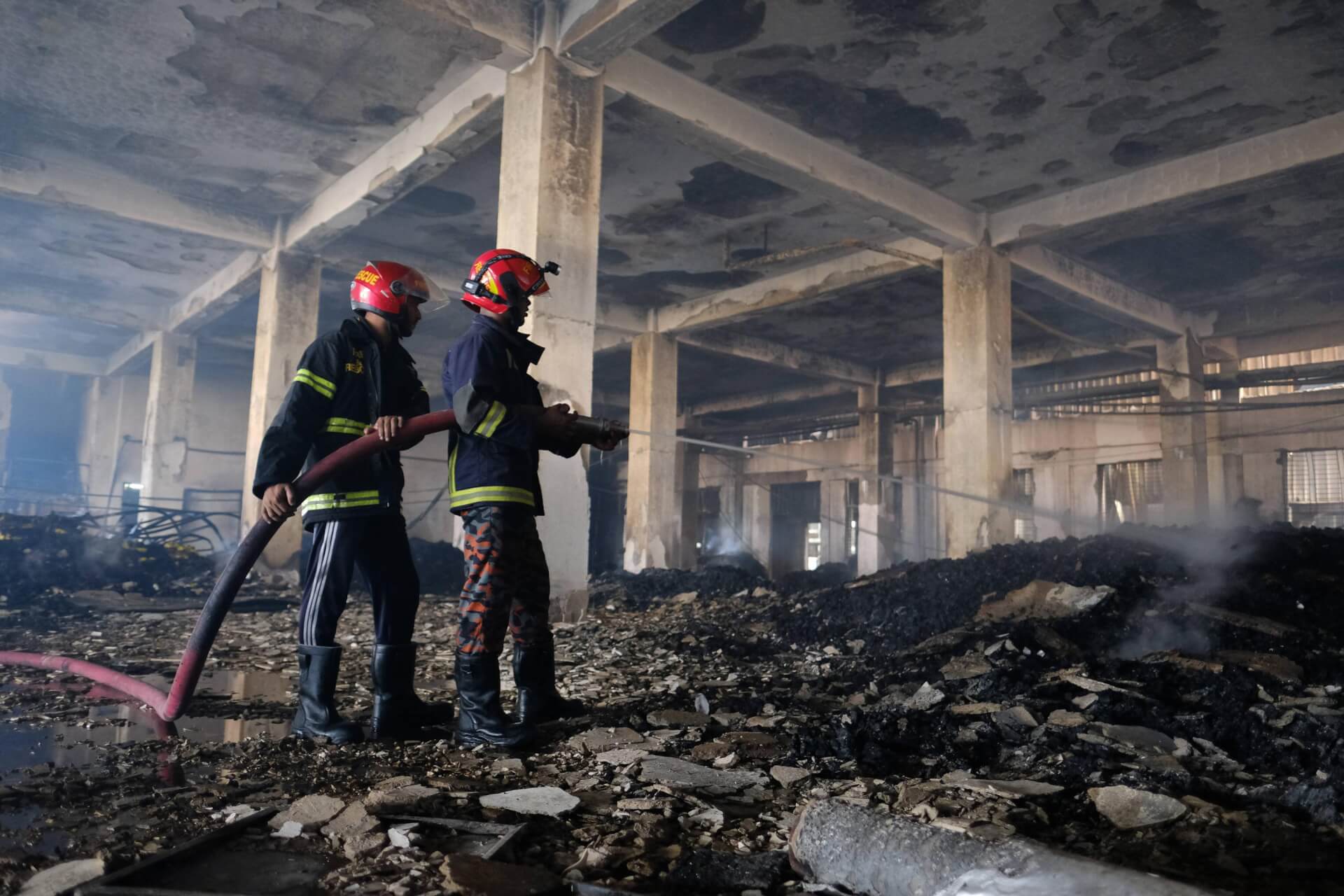The death toll from an explosion at the BM Container Depot in Shitolpur has risen to 49, generating a new wave of concerns about safety regulations and labour codes in a country where such incidents have become all too common. In fact, the total number of deaths from the incident is only likely to rise, as 20 others remain in a critical state with 60-90% of their bodies covered in burns.
The fire started at 9:35 PM on Saturday at the CM Container Depot Limited, which was set up as a joint venture between Bangladesh and Netherlands to store goods for import and export from the Chattogram port. The fire was finally contained after 25 hours.
Rescue operations were conducted by police and fire services, along with army personnel. According to the assistant director of the Fire Service and Civil Defence, Faruk Hossain Sikdar, 20 units of firefighters and 25 fire brigades were deployed to control the fire. However, they struggled to gain access to the facility, as the fire was being intensified by hydrogen peroxide; reports suggest that the containers were storing chemicals, which could have further fuelled the fire.
Sad to hear about the loss of precious lives in a fire incident in Bangladesh. My heartfelt condolences & most sincere sympathies are with the government and people of Bangladesh.
— Shehbaz Sharif (@CMShehbaz) June 6, 2022
Fire services reported nine fire personnel died and 15 others were injured in secondary explosions during rescue operations; two fire fighters are currently missing.
Bangladesh’s state-owned media service reported that in total 300 people were injured in the explosion, including fire and police personnel, a majority of whom have reported burn injuries and are undergoing treatment in hospitals across the district. The Dhaka Tribune, on the other hand, reported over 450 injuries.
Only 13 bodies have been identified and handed over to family members. The other 36 bodies were charred beyond recognition; police authorities are conducting DNA tests to ascertain their identities.
#Bangladeh ## More than 30 people were killed including Fire fighters and many injured in a massive fire broke out at #BM Container depot .
— Syeda Shabana (@ShabanaANI2) June 5, 2022
Fire started from a container which had hydrogen peroxide in it resulted in an explosion said Sources pic.twitter.com/pJX6CR0pJY
Representatives of the company said the families of the workers that died in the fire will receive 10 lakh Bangladeshi taka ($11,200). workers who were critically injured will receive six lakh Bangladeshi taka ($6,700) and those who have lost a body part will be compensated with four lakh Bangladeshi taka ($4,500). The company has also set up an inquiry committee to investigate the incident.
Saturday’s fire has once again given rise to concerns about safety regulations and labour laws in Bangladesh, as reports suggest that the 24-acre facility had only one fire exit. According to rescuers quoted by Dhaka Tribune, the number casualties of could have been significantly reduced if there were other exits, as evacuation efforts would have been much more efficient.
Bangladesh army joins works to control Ctg depot fire.
— Bangladesh Military Affairs (@MilitaryBMA_BD) June 5, 2022
Members of the Bangladesh Army joined in the works of controlling the fire at the BM Container Depot under Sitakunda upazila in Chattogram on Sunday morning. pic.twitter.com/W25AtXSdPn
Such fire tragedies have become a common occurrence in Bangladesh, particularly in the garment industry, which makes up 80% of the country’s exports.
In 2012, 117 people died in a fire at a garment factory in Dhaka. Upon investigation, it was found that the workers were trapped inside behind locked exits. Soon after, in 2013, over 1,000 people were killed in the Rana Plaza disaster. Following this incident, authorities vowed to enforce safety norms more strictly; however, there has been no significant decline in these incidents.
In February 2019, a fire caused by illegally stored chemicals in Dhaka Apartments, a neighbourhood that houses several residential apartments, warehouses, and shops, killed 70 people.
A massive fire broke out at Sitakunda #Chattogram early this morning. Death toll so far stands at 49 with hundreds of people severely injured.
— Espen Rikter-Svendsen (@NorwayAmbBD) June 5, 2022
Devastated and saddened. Hope all necessary measures will be taken to avoid this kind of disaster from happening again.@NorwayMFA pic.twitter.com/PDuYqxg4sy
Similarly, last July, a major fire ravaged a food and beverage factory at Rupganj, killing at least 50 people. Emergency services said the incident was caused by highly flammable chemical substances and plastics stored at the facility. The exit door that led to the main staircase was padlocked, preventing workers from escaping the fire. In addition, the building had only two staircases despite being legally required to maintain at least five as per safety regulations.
Corruption and unenforced rules and regulations have led to several such deadly incidents over the years. These events have drawn criticism about the complicity of global retailers and companies. For instance, the BM Container Depot was reported to be storing “millions of dollars’ worth of garments” ready to be exported to Western retailers.

